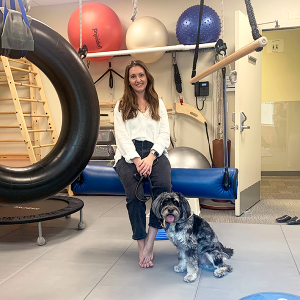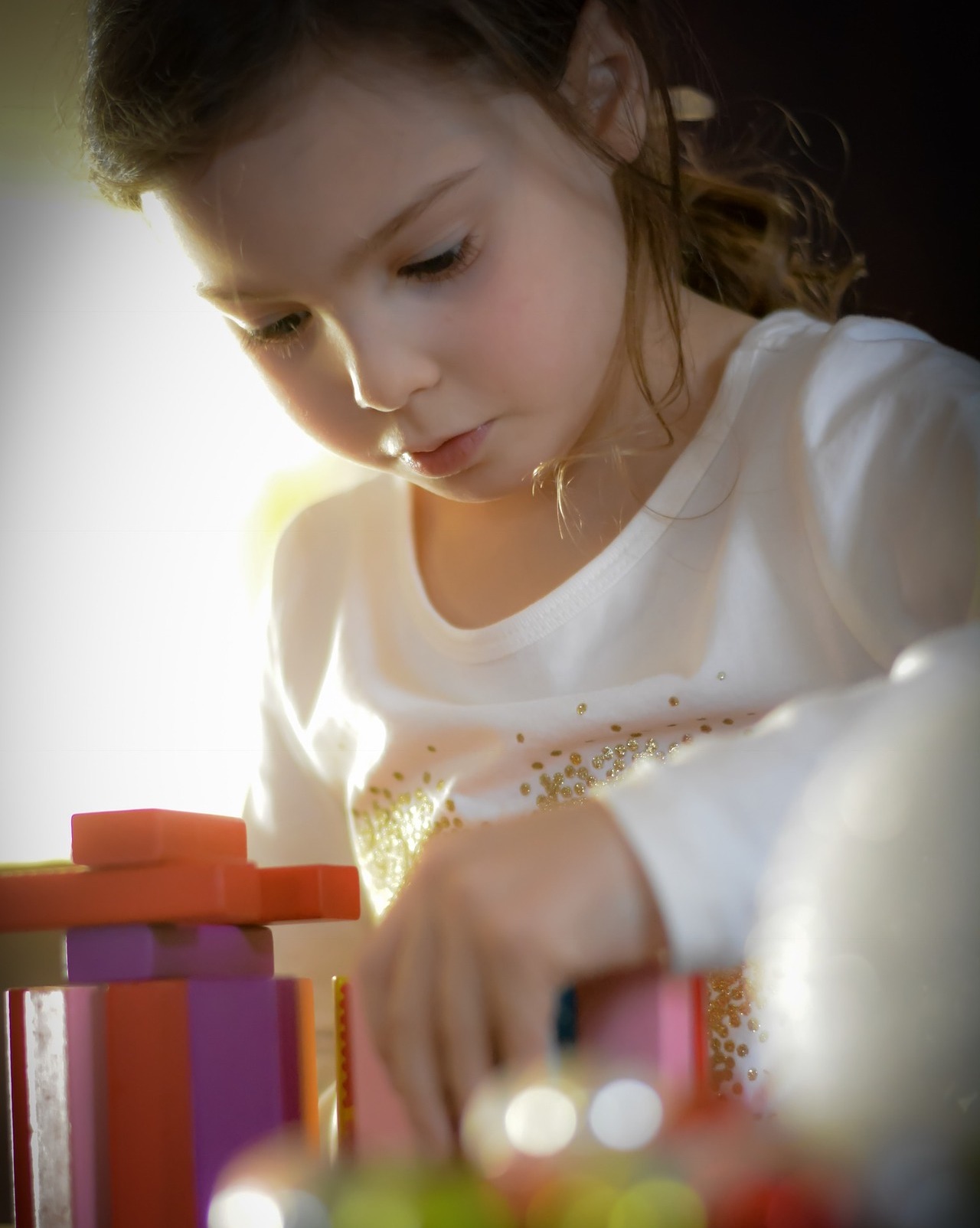CHC’s Occupational Therapy Gym Gets a Spring Refresh

What if a therapy room felt more like a playground? What if there were soft mats covering the floor, colorful walls, climbing spaces, and swinging trapezes? And what if, upon entering this special space, you were greeted by a friendly mini Aussiedoodle? This magical space you’re envisioning isn’t a mere fantasy—it’s the occupational therapy gym at CHC.
Having recently undergone a spring refresh, with a new color palette and streamlined storage that creates more space, this specially designed room is now more appealing than ever to CHC’s young clients.
Occupational therapist Pamela Olson explains the goals behind the room’s updates: “We really wanted to make the gym feel even more inviting for clients and families. We lightened up the room with new gray mats for a soothing feel and balanced the energy with a bright blue accent wall behind the fine motor table, creating a welcoming space.”
Working on skills in a playful way
Olson says the OT gym allows her clients the space to move their bodies and build motor skills and self-regulation skills in a playful way. “I want to provide clients with autonomy in choosing what they want to do in the OT gym. At the same time, I’m considering a whole scheme of how I am going to work on goals within those chosen activities. For example, I might have a child create their own obstacle course path. While they see this as an opportunity to play and move their body, I am seeing opportunities to work on their motor planning, motor strength, and sensory processing skills.”
CHC’s occupational therapists meet with their young clients at the OT gym to work on skills that will help address their developmental, physical, sensory, and cognitive needs. Some of the specific areas in which the OT gym can be helpful:
- Improving motor skills: The OT gym’s tools and equipment can help children develop fine motor skills (such as writing, drawing, and using utensils) and gross motor skills (like walking, running, and jumping). OTs may use climbing structures, balance beams, and balls to improve clients’ coordination and strength.
- Sensory integration: Many kids, especially those with sensory processing disorders, benefit from sensory integration activities. These activities help children regulate their responses to sensory stimuli, such as touch, sound, and movement.
- Supporting academic skills: OTs may work on activities that support academic skills like handwriting, reading, and math. For example, games and exercises can improve hand-eye coordination, visual perception, and attention span, which are essential for classroom success.
- Building confidence and self-esteem: Positive experiences in the OT gym can boost a child’s confidence and self-esteem. As they overcome challenges and achieve milestones, they gain a sense of accomplishment that can carry over into other areas of their lives.
Special feature: Jetty the therapy dog
One extra-special feature of CHC’s OT gym: Jetty, Olson’s sidekick and therapy dog. Jetty is trained to lie across a child’s lap or belly for deep reassuring pressure, or to rest his chin on their non-dominant hand when they’re working on handwriting. Sometimes just sharing space with him can be a mood lifter for a child who’s having a tough day.
“If a child is having a hard time following directions or is experiencing larger emotions, I might involve Jetty. I might encourage them to make an obstacle course path for Jetty to complete first. Or I will make a path to a tennis ball, and once the child gets the ball, they’ll get a break to throw the ball for Jetty. Sometimes working with Jetty will motivate the child and support them in working through those initial emotions.”
Jetty can also help clients work on their spatial awareness, Olson says. “I’ll let Jetty walk around the gym space as a child is moving through an obstacle course, and use that as a way to challenge the child’s ability to move around while being aware of Jetty moving around at the same time. It’s a great way to practice this skill area.”
A versatile resource
Olson says the OT gym is a crucial tool in her work with clients.
“The OT gym helps me make skills that are hard for clients more accessible, so that they can have those little aha moments. Those aha moments aren’t always ones that the clients are aware of, but I can see their body do something and can tell that they receive the input I was trying to provide through use of the equipment in the room. It’s a fun way for clients to make progress on the skills they are working on.”
CHC is proud to offer several specialized rooms designed to support children with specific therapeutic needs. Our wide array of facilities allows us to meet clients wherever they are in their developmental journey, and to ensure that we can tailor our services to their needs at every step along the way.
CHC is here for you
If you have concerns about your child, don’t hesitate to seek guidance from professionals who can provide targeted support! Get started by emailing or booking a phone call with our CHC Care Team.
Pamela Olson , MOT, OTR/L has over ten years of working with children and adolescents with varying needs, across clinic, home, and school environments in the Bay Area. She has extensive education in sensory integration, motor skill development, cognitive skills and processes, and use of alternative therapeutic modalities (i.e. yoga and mindfulness).
, MOT, OTR/L has over ten years of working with children and adolescents with varying needs, across clinic, home, and school environments in the Bay Area. She has extensive education in sensory integration, motor skill development, cognitive skills and processes, and use of alternative therapeutic modalities (i.e. yoga and mindfulness).







